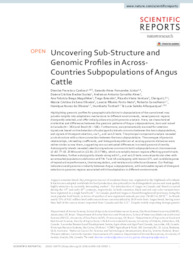Uncovering sub-structure and genomic profiles in across-countries subpopulations of Angus Cattle.
Uncovering sub-structure and genomic profiles in across-countries subpopulations of Angus Cattle.
Author(s): CARDOSO, D. F.; FERNANDES JÚNIOR, G. A.; SCALEZ, D. C. B.; ALVEZ, A. A. C.; MAGALHÃES, A. F. B.; BRESOLIN, T.; VENTURA, R. V.; LI, C.; OLIVEIRA, M. C. de S.; PORTO NETO, L. R.; CARVALHEIRO, R.; OLIVEIRA, H. N. de; TONHATI, H.; ALBUQUERQUE, L. G.
Summary: Highlighting genomic profiles for geographically distinct subpopulations of the same breed may provide insights into adaptation mechanisms to different environments, reveal genomic regions divergently selected, and offer initial guidance to joint genomic analysis. Here, we characterized similarities and differences between the genomic patterns of Angus subpopulations, born and raised in Canada (N?= 382) and Brazil (N = 566). Furthermore, we systematically scanned for selection signatures based on the detection of autozygosity islands common between the two subpopulations, and signals of divergent selection, via FST and varLD tests. The principal component analysis revealed a sub-structure with a close connection between the two subpopulations. The averages of genomic relationships, inbreeding coefficients, and linkage disequilibrium at varying genomic distances were rather similar across them, suggesting non-accentuated differences in overall genomic diversity. Autozygosity islands revealed selection signatures common to both subpopulations at chromosomes 13 (63.77?65.25 Mb) and 14 (22.81?23.57 Mb), which are notably known regions affecting growth traits. Nevertheless, further autozygosity islands along with FST and varLD tests unravel particular sites with accentuated population subdivision at BTAs 7 and 18 overlapping with known QTL and candidate genes of reproductive performance, thermoregulation, and resistance to infectious diseases. Our findings indicate overall genomic similarity between Angus subpopulations, with noticeable signals of divergent selection in genomic regions associated with the adaptation in different environments.
Publication year: 2020
Types of publication: Journal article
Observation
Some of Embrapa's publications are published as ePub files. To read them, use or download one of the following free software options to your computer or mobile device. Android: Google Play Books; IOS: iBooks; Windows and Linux: Calibre.
Access other publications
Access the Agricultural Research Database (BDPA) to consult Embrapa's full library collection and records.
Visit Embrapa Bookstore to purchase books and other publications sold by Embrapa.

